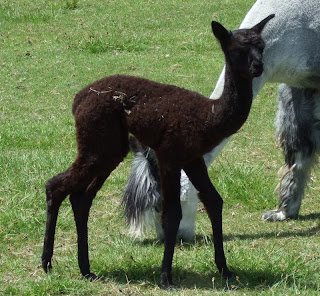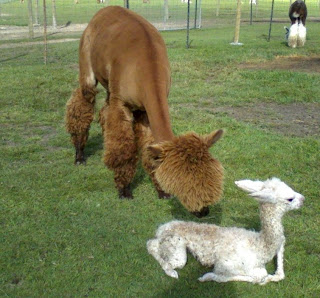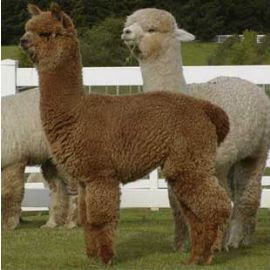 It has been a very busy time so, unfortunately, we are a tad late in reporting the most recent births.
It has been a very busy time so, unfortunately, we are a tad late in reporting the most recent births.On June 17th we were very happy to welcome Tucker Creek's McKenzie, a beautiful 17 pound bay black female out of Marcella and our outstanding herdsire, Sun Tzu. She is the first of eight cria we are expecting out of Sun Tzu this year and are most excited as this is his first season. She was certainly everything we had hoped to see. She has dense curly fiber with a very soft handle.
On the 20th Autumn Sunshine delivered an impressive 17 pound pure wh ite baby boy out of Pacific Crest Accoyo Paul Revere. Like all of Paul Revere's cria, Tucker Creek's Nnyrok has very curly dense fiber. He was one our speediest crias to stand and nurse completing the entire process in less than one hour. He is half Accoyo and Full Peruvian--and a second generation Studmaster progeny--should be very fun watching this young male grow up.
ite baby boy out of Pacific Crest Accoyo Paul Revere. Like all of Paul Revere's cria, Tucker Creek's Nnyrok has very curly dense fiber. He was one our speediest crias to stand and nurse completing the entire process in less than one hour. He is half Accoyo and Full Peruvian--and a second generation Studmaster progeny--should be very fun watching this young male grow up.
 ite baby boy out of Pacific Crest Accoyo Paul Revere. Like all of Paul Revere's cria, Tucker Creek's Nnyrok has very curly dense fiber. He was one our speediest crias to stand and nurse completing the entire process in less than one hour. He is half Accoyo and Full Peruvian--and a second generation Studmaster progeny--should be very fun watching this young male grow up.
ite baby boy out of Pacific Crest Accoyo Paul Revere. Like all of Paul Revere's cria, Tucker Creek's Nnyrok has very curly dense fiber. He was one our speediest crias to stand and nurse completing the entire process in less than one hour. He is half Accoyo and Full Peruvian--and a second generation Studmaster progeny--should be very fun watching this young male grow up.As the birthing season continues one truth comes to mind . . . as more crias arrive the more important it becomes to take a really hard look at the herd and make some decisions on what we want it to look like. Who should be included in our foundation herd? What animals do we want to sell? What are the characteristics of the females left to deliver? Considering the severity of the winters on the Oregon Coast what is the ideal size herd in preparation for winter (this is more of personal issue than an alpaca husbandry issue--we prefer fewer critters through the winter). So to that end begins our annual evaluation of our herd which consists of 62 animals as of this writing with 16 more crias due by year end. Ideally we would prefer to go through the winter with a herd closer to 40. Many of the prices on our website have already been reduced--so it is a great time to add some wonderful animals to your herd as our Summer Sale begins now!




